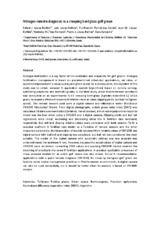Nitrogen remote diagnosis in a creeping bentgrass golf green
Autor
López-Bellido Garrido, Rafael J.
López Bellido, Luis
Fernández García, María Purificación
López-Bellido, Juan M.
Muñoz-Romero, Verónica
López-Bellido Garrido, Pedro José
Calvache Gil, Sara
Editor
Science DirectFecha
2012Materia
TurfgrassPutting green
Green speed
Bermudagrass
Precision agriculture
Normalized difference vegetation index (NDVI)
Algorithm
METS:
Mostrar el registro METSPREMIS:
Mostrar el registro PREMISMetadatos
Mostrar el registro completo del ítemResumen
Nitrogen fertilization is a key factor of the aesthetics and playability for golf greens. Nitrogen fertilization management is based on predetermined scheduled applications, set rates, or expected improvement in visual quality and green speed. As a consequence, the objective of this study was to obtain seasonal N application models (algorithms) based on remote sensing, optimizing playability and aesthetic quality. A 3-yr field study under Mediterranean conditions was conducted on an experimental ‘L-93’ creeping bentgrass (Agrostis stolonifera L.) USGA green, to examine effects of seasonal N fertilizer rates on color, clipping yields, and ball roll (green speed). The remote sensors used were a digital camera and reflectance meter (FieldScout CM1000 Chlorophyll Meter). From digital photographs, a dark green color index (DGCI) was calculated. All data were normalized (relative). For all seasons, a third-order polynomial response model was the best when using a CM1000 and a digital camera. Clipping yields and ball roll regressions were linear, increasing and decreasing when the N fertilizer rate increased, respectively. Ball roll and clipping relative values were correlated with both sensors. To fit a seasonal optimum N fertilizer rate model as a function of remote sensors and the other measured parameters, the intersection of models obtained from relative values of CM1000 and digital camera with ball roll and clipping was calculated, but ball roll was considered the most suitable. The model of the digital camera with automatic settings was less accurate and underestimated the optimum N rate. However, because the actual values of digital camera and CM1000 were correlated, converting DGCI values and applying CM1000 models enabled the obtaining of practically the same N fertilizer applications. A practical application procedure of these seasonal models for an entire golf course was also shown. Actual N recommendation applications with a quick remote diagnosis (CM1000) for creeping bentgrass golf green are feasible under similar management practices in Mediterranean environments. A digital camera can also be used successfully, but it should be better when its analysis is based on CM1000 models.

